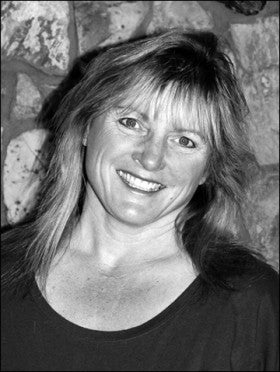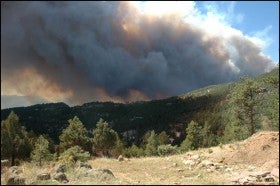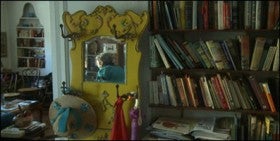Five questions for Michelle Carpenter
Using experimental video and installation works,Michelle Carpenter brings focus to difficult subject matter including women's issues such as domestic violence and body image, along with life-transforming events that have occurred in her life.
The assistant professor of digital design in the College of Arts and Media at the University of Colorado Denver also understands the importance of community engagement and giving back, and works with her students to develop communications tools for local nonprofits.
One of Carpenter's current projects – focusing on a life-transforming event – is the development of an experimental video piece that examines how human memory works. In 2000, her grandmother was diagnosed with Alzheimer's disease. The video explores the richness of memory, and the immediate, working and long-term processes of remembering. She plans to experiment with projecting video (text and image) onto mist or smoke to further suggest the transient nature of memory. Ironically, Michelle's grandmother had carefully documented her daily life in a diary almost as if she knew she would lose her memory. Those diaries will become a central element to the piece.
Carpenter came to Colorado in 1986 to visit friends in Boulder. She had planned to stay for two weeks then head to Los Angeles, but fell in love with the state and never looked back. She received her bachelor's and master's degrees from the University of Colorado at Boulder.
"I have had amazing career opportunities and experiences and I couldn't be more impressed with my colleagues here at the University of Colorado Denver and their skills and exhibition and screening records," she said. "Colorado draws talent and keeps it because of the state's beauty, climate and people."
Her experimental pieces and documentaries have been screened at local, national and international film festivals and in art galleries. She hopes to one day receive an award from the Black Maria Film and Video Festival, a highly respected event that features cutting-edge independent and experimental video and film work. Another of her goals is to be granted funding from the Sundance Documentary Institute for a feature-length documentary that would be screened at the Sundance Film Festival.
Carpenter and her family enjoy Colorado's resources: rock climbing, biking and hiking in the summer and skiing in the winter. Both her sons downhill ski race for the Eldora Mountain Ski Club and in the spring and summer are consumed by Little League and tournament team baseball. The arts aren't neglected: Her children are learning to shoot and edit video.
— Cynthia Pasquale
1. At your website, you write, "In my artwork I have sought to relate the complexity of emotion. Utilizing personal narrative, irony and gathered experiences, my work discusses the manifestation of violence, social constraints and personal loss." How did you come to focus on these topics?
My creative research consists of two distinct styles of art making: traditional narrative video and experimental video documentary. The content of my experimental work is driven by and created in response to primary experiences in my life. I draw from personal experiences to develop documentaries, experimental single-channel videos or video installations that encourage discourse on difficult subject matters, including domestic violence, women's body issues, breast cancer and Alzheimer's. One of my video/installation pieces, "Rule of Thumb," was fueled by an experience with domestic violence in the mid-1980s. This piece asks the viewer to critically question manifestations of violence in relationships.
No matter how much feminist theory I read or how many times I deconstruct the myth of ideal beauty, I still have problems accepting and being happy with my body type. "Alterations" is an installation that addresses the surgical alteration of women's bodies and social concepts of beauty. This project is an environment that combines projected video, computer-generated images, sculptural forms such as mannequins and other objects. The video is a montage of images including surgery footage with related audio. Each of the three mannequin forms are pierced with 5,000 steel pins and hundreds of red threaded needles, reflecting our painful cultural obsession with the ideal body.
2. You live in the Fourmile Canyon area, a place that recently was ravaged by fire. Will you use this experience for an upcoming video piece?
My family and I live in the historic mining town site of Sunshine located in the middle of the burn area. The losses our friends suffered are absolutely heartbreaking. Out of 71 homes in our neighborhood, 42 were lost to the fire, so as soon as we were finally allowed back home, I began documenting the devastation. Even while we were being evacuated, I began to gather stories from friends and neighbors. I listened to the fire/police scanner 24/7 because getting information about the fire was nearly impossible. We found out early during the evacuation that three of our neighbors refused to leave. These three men basically saved the old town site and one saved our house by putting out flying embers with a shovel and dirt. Another saved four dogs that had been left in Sunshine. There are so many heroic stories to share and I hope to have the documentary completed by spring 2011. Making art about my experience with the fire helps me process the loss and hopefully, in some small way, will do the same for others.
3. Your digital design students have designed materials for local groups and nonprofits. This is the second year your classes have done design work for groups. How did the program begin?
I worked in the nonprofit sector for 10 years, first at PBS and then at Free Speech TV. I know the importance of community engagement and how good it feels to give back to your community. As a designer artist, I have donated magazine layouts, websites, PSAs and fundraising videos to various nonprofits and schools because community service is an important part of my life.
When I began teaching at the University of Colorado Denver in 2000, I taught with a professor in English named Ellen Cushing. She had set up a class called "Multimedia in the Community" and it was a perfect match for my experience. I taught the class for six years. Students learned how to create narrative and documentary videos and for their final project in the class we would create a PSA for a local nonprofit. In 2007, when I became an assistant professor in digital design for the College of Arts and Media (CAM), I wanted to make the nonprofit component in learning larger to give the students a real client/designer experience and to deliver a larger body of artwork to the nonprofit. In this senior-level class, called Design Studio 3, students create a full design identity for a nonprofit, including a design brief, logotype, a website and a promotional video. It's promoting the adage, "Learning to be good (designers) while doing good."
(To see examples of the projects, visit The Sheridan Clinic http://www.sheridanhealthservices.com/ – click on the "Kids" page – and the High Plains Research Network http://www.hprn.net, on the "About" page.)
"Del:100" is a visually haunting documentary short that highlights the career of centenarian journalist Dolores Plested.
Michelle Carpenter edited and co-produced the film with Craig Volk (director) and Stephanie Two Eagles. "Del:100" will be screened during the Starz Denver Film Festival, Nov. 3-14. The film will be shown with two other films, "Red Shirley" and "Les Complices" at 6:45 p.m. Nov. 7 and 9:15 p.m. Nov. 8.
Born in 1908, Plested witnessed and reported on many of the major events of the 20th century. Her life experiences included writing for The New York Times and The Ladies Home Journal in the 1940s, observing the Hindenburg dirigible before its tragic crash, and meeting many celebrities.
Later, she was a trailblazing female reporter in Colorado who covered Eisenhower, Nixon and J. Edgar Hoover when Ike had his summer White House in Denver. Del also covered Jackie Kennedy's Aspen holiday with John-John and Caroline. Her life is celebrated in her own words and accompanied by poetic cinematography and a jazz score.
Carpenter's work part of Starz Film Fest"Del:100" is a visually haunting documentary short that highlights the career of centenarian journalist Dolores Plested.Michelle Carpenter edited and co-produced the film with Craig Volk (director) and Stephanie Two Eagles. "Del:100" will be screened during the Starz Denver Film Festival, Nov. 3-14. The film will be shown with two other films, "Red Shirley" and "Les Complices" at 6:45 p.m. Nov. 7 and 9:15 p.m. Nov. 8.Born in 1908, Plested witnessed and reported on many of the major events of the 20th century. Her life experiences included writing for The New York Times and The Ladies Home Journal in the 1940s, observing the Hindenburg dirigible before its tragic crash, and meeting many celebrities.Later, she was a trailblazing female reporter in Colorado who covered Eisenhower, Nixon and J. Edgar Hoover when Ike had his summer White House in Denver. Del also covered Jackie Kennedy's Aspen holiday with John-John and Caroline. Her life is celebrated in her own words and accompanied by poetic cinematography and a jazz score.
4. What would you consider one of your best achievements?
"Good Grief" offered seven nights of comedy and drama showcasing unique Colorado talent. This original television miniseries was shot entirely in the Tivoli on the Auraria campus during the summer of 2008. "Good Grief" was originally scripted by Craig Volk, a professional television writer and a CAM colleague as part of his episodic television writing class at UC Denver. I did the editing for the entire series. "Good Grief" ran on the Rocky Mountain PBS network in January 2009 and continues to air worldwide via RMPBS' website.
As editor, it was my job to establish the episode's overall visual form and to remain true to the creative vision of the director. Editors find and carve the best performances of the actors; they establish the intimate relationships we have with the screen characters and I love that role in the process. In addition to entertainment, "Good Grief" examines the complexities of our lives including family, war, racism, violence, economic hardship, higher education issues, medical ethics, social myth and personal loss. It was enormously rewarding.
5. Recently, an art piece in a Loveland gallery caused a bit of controversy for its depiction of Jesus in what appears to be a sex act. These types of incidents happen regularly. What are your thoughts about such artwork and an artist's freedom to create without censorship?
Freedom of speech/expression is a First Amendment right afforded to all of us through the U.S. Constitution, yet I know that as an artist and an educator, how artwork fits into this right can be challenging. It is important to look at the context, the audience and the purpose. Most museums consider their audience and community when they curate artwork and while I am not privy to the details of the case, I was saddened to hear that an artwork was destroyed and wish this complex issue could have been resolved in a more peaceful manner.
Want to suggest a faculty or staff member for Five Questions? Please e-mail Jay.Dedrick@cu.edu




